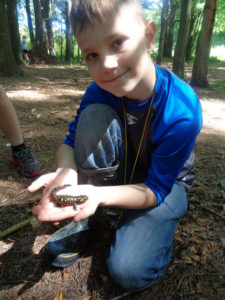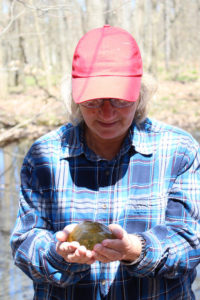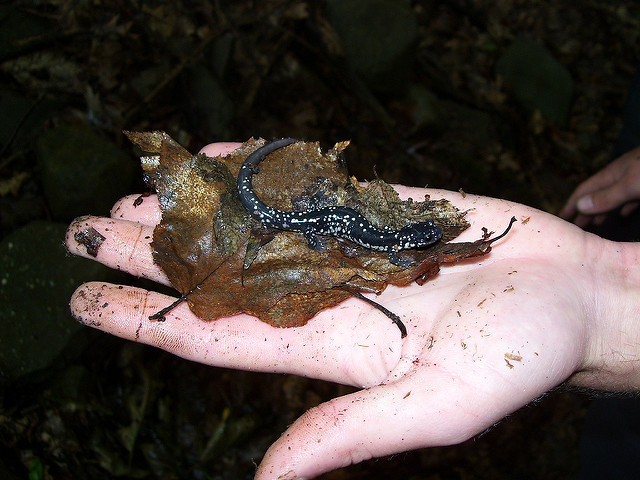When most people think of spring they usually think of spring flowers appearing and birds flying back from their winter vacations. Sure, flowers and birds are sure signs of spring is on its way, but do you know what always tells me spring is here? Salamanders.
Growing up I spent my summers catching salamanders in and near the stream behind my house. The neighborhood kids and I could spend all day flipping over rocks in search of Red-Back and Two-Lined Salamanders. If we were really lucky we would roll over a big decomposing log and find a Spotted Salamanders. While I loved finding and catching salamanders I didn’t really think about what they did the rest of the year. That was until I experienced my first spring salamander migration.
 Salamanders are amphibians—they lay eggs, are cold-blooded and spend part of their life in the water, and part of their life on land—and unlike mammals and birds amphibians don’t have fur or feathers to keep themselves warm. Therefore, to survive the cold winter weather some salamanders burrow underground or under logs to keep themselves safe and warm. In the spring when the temperature gets warmer and the ground starts to thaw these salamanders emerge from the woods by the hundreds to look for a vernal pool to mate and breed.
Salamanders are amphibians—they lay eggs, are cold-blooded and spend part of their life in the water, and part of their life on land—and unlike mammals and birds amphibians don’t have fur or feathers to keep themselves warm. Therefore, to survive the cold winter weather some salamanders burrow underground or under logs to keep themselves safe and warm. In the spring when the temperature gets warmer and the ground starts to thaw these salamanders emerge from the woods by the hundreds to look for a vernal pool to mate and breed.
Vernal pools, also known as ephemeral pools, are shallow, temporary wetlands that form in the early spring and disappear by the end of the summer. Unlike other wetlands, vernal pools do not have inlets or outlets, so they are filled entirely by snowmelt and rain.
To the untrained eye vernal pools probably just look like large puddles in the woods, but to many insects and amphibians these pools are vital to their survival. In fact, for some species vernal pools are the only place that they will lay their eggs.
There are many advantages to laying your eggs and raising your young in vernal pools, but the most important is that vernal pools cannot support fish and other animals that commonly feed on salamanders and their eggs. In order to survive fish need a habitat that is filled with water year-round. If their habitat dries up, so do they. Salamanders also need water and moisture to survive, but by the time the vernal pools start to dry up these amphibians can walk away on their new legs.
Just like most things, salamander migration is all about timing. Emerge too early in the spring and the salamanders risk freezing to death. Emerge too late and the vernal pools might dry up before their young are fully developed.
 Of course, conditions have to be just right for salamanders to start moving. When I worked in Syracuse my coworker would tell me that the biggest migration would take place as soon as the snow around the vernal pools had melted and we got a rainy night above fifty. Some articles suggest that the temperature just has to be above forty.
Of course, conditions have to be just right for salamanders to start moving. When I worked in Syracuse my coworker would tell me that the biggest migration would take place as soon as the snow around the vernal pools had melted and we got a rainy night above fifty. Some articles suggest that the temperature just has to be above forty.
I’m sad to say I’ve already missed the first salamander migration of the year. While many of my coworkers tried to convince me that the weather was going to be perfect for salamanders to start moving I wasn’t convinced that the ground defrosted enough. Sure enough, when I walked out to the vernal pool early last week I found signs of Jefferson and Spotted Salamanders that had probably moved the night before. Hopefully we will get one more big migration as the weather continues to warm up over the next couple of weeks.
Want to learn more about salamanders and other amphibians? Check out Awesome Amphibians on Saturday, April 14th at 1pm. During this program an Audubon Naturalist will teach you all about what makes an amphibian an amphibian and introduce you to some of our local favorites. Don’t miss it!
Margaret Foley is a Naturalist at Audubon Community Nature Center.
Audubon Community Nature Center builds and nurtures connections between people and nature. ACNC is located just east of Route 62 between Warren and Jamestown. The trails are open from dawn to dusk as is Liberty, the Bald Eagle. The Nature Center is open from 10 a.m. until 4:30 p.m. daily except Sunday when it opens at 1 p.m. More information can be found online at auduboncnc.org or by calling (716) 569-2345.


Recent Comments